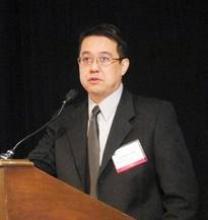MILWAUKEE – The risk for worse outcomes following carotid-artery stenting may extend to even younger Medicare-age patients than previously reported by such pivotal trials as CREST, a provocative population study suggests.
The rate of the composite primary end point of death, stroke, or cardiac complications was 5.2% for carotid angioplasty and stenting (CAS) and 3.6% for carotid endarterectomy (CEA) among patients younger than age 65 years, and was 6.3% vs. 4.5% among patients aged 65 years or older, who comprised 76% of the study cohort (both P values less than .0001).
Rates of the primary end point were similar between the carotid stenting and endarterectomy groups among asymptomatic patients aged 65 years or older (4.1% vs. 3.8%; P = .25), but were significantly higher in symptomatic patients age 65 years or older who received stenting (22.5% vs. 12.5%; P less than .0001).
This finding was driven by significantly higher rates of all three individual components of the primary end point: death (5.1% vs. 2.2%), stroke (12.5% vs. 7.6%), and cardiac complications (7.5% v s. 4.2%), "which is a little bit different than what we thought, compared with the CREST trial," lead author Dr. Jeffrey Jim said at the annual Midwestern Vascular Surgical Society meeting.
In the lead-in phase of CREST (Carotid Revascularization Endarterectomy vs. Stent Trial), octogenarians were found to be at higher risk of in-hospital death and stroke post CAS, but not myocardial infarction (J. Vasc. Surg. 2004;40:1106-11).
Subsequent CREST analyses have identified an interaction between age and carotid stenting efficacy, with the crossover at an age of approximately 70 years (N. Engl. J. Med. 2010;363:11-23).
The current results appear to move that threshold to an even younger age, just as the Centers for Medicare and Medicaid Services starts reconsidering the national coverage decision for carotid-artery stenting. Although he did not present the data, Dr. Jim noted that hospital costs also were higher for stenting patients.
"Our results show that carotid angioplasty and stenting was associated with a higher rate of adverse outcomes and increased charges among patients of Medicare age, and really don’t support the widespread use of carotid stenting over CEA in this general population," Dr. Jim said.
Session moderator Dr. Patrick Geraghty, a vascular surgeon with Barnes–Jewish Health in St. Louis, said the difference in MI rates between arms "basically turns the CREST findings on their head," and asked whether cardiac troponin levels were tracked equally in both arms.
Dr. Jim responded that such tracking wasn’t possible with the Nationwide Inpatient Sample (NIS) database used for the analysis, and that it’s unknown whether one hospital called a troponin level of 0.15 ng/mL a troponin leak, while another coded that as an MI. Anatomic information and operative details also were not available.
The analysis was based on 678,081 hospitalizations for CEA and CAS from 2005 to 2009, the latest available data in the NIS, a comprehensive, inpatient database developed as part of the Healthcare Cost and Utilization Project and designed to approximate a 20% sample of U.S. hospitals.
The 595,813 CEA patients were more likely to be asymptomatic, whereas the 82,268 CAS patients were more likely to be male, medically high risk, treated at a teaching hospital, and an emergent/urgent admission.
The average age was 71 years in the CEA group and 70 years in the CAS group. Three-fourths of both groups had Medicare insurance coverage.
In the entire study cohort, the composite primary end point occurred in 6% of the carotid stenting group and 4.3% of the endarterectomy group (P less than .0001), said Dr. Jim, a vascular specialist at Washington University School of Medicine, St. Louis.
Patients who underwent carotid stenting experienced significantly higher rates of each individual component of the primary end point: death (1.1% vs. 0.5%), stroke (2% vs. 1%) and cardiac complications (3.6% vs. 3.1%).
Independent predictors of the primary end point were CAS, symptomatic stenosis, and medical high risk, defined as a patient age 80 years or older, or a patient who had renal failure, severe chronic lung disease, recent MI, coronary bypass/valve surgery within 30 days, unstable angina, or class III/IV heart failure.
Dr. Jim and Dr. Geraghty reported having no relevant conflicts of interest.



